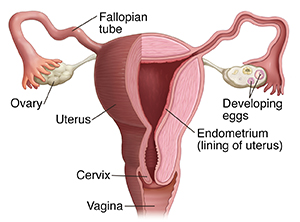Understanding the Normal Menstrual Cycle
Having a period (menstruation) is a normal, healthy part of being a person born with a uterus. It begins at puberty (10 to 16 years) and ends at menopause at an average age of 51. It’s also part of the menstrual cycle, a process that makes it possible to become pregnant. The first day of bleeding (your period) is the first day of your menstrual cycle. The menstrual cycle is regulated by hormones.
Irregular cycles
If you have irregular cycles, you can become pregnant during bleeding. This may not be a true menstrual period.
An egg is released
Eggs are female reproductive cells stored in the ovaries. During each cycle, the hormones trigger an egg, (usually one), to mature and be released from an ovary. This is called ovulation. The egg then travels from the ovary to a fallopian tube. Pregnant and menopausal women do not ovulate.
Some women feel a dull pain on one side of the lower abdomen during the time of ovulation.

The egg travels through a tube
The egg moves through the fallopian tube toward the uterus. An egg lives for just 12 to 24 hours after ovulation. If sperm are present in the tube, the egg may be fertilized, and pregnancy could result.
The uterine lining grows thicker
The lining of the uterus is made up of blood, tissue, and fluid. During each cycle, hormones cause the lining to get thicker. This helps prepare the uterus to receive and nourish a fertilized egg.
The egg and lining are shed
If pregnancy doesn’t happen, the unfertilized egg and the thickened lining of the uterus are no longer needed. So the hormone levels drop and the extra tissue lining the uterus is shed through the vagina. This is called a menstrual period.
How long is each cycle?
It's normal for a cycle to take 21 to 34 days. For teens, the time between periods might be as much as 45 days. For adults, it will be around a month from the first day of one period to the first day of the next. That’s why you may hear about a “monthly cycle,” even though cycle length can vary from 1 month to another, and anywhere from 3 to 5 weeks is normal. Not everyone has a 28-day cycle.
How long does a period last?
It’s normal for a period to last 2 to 7 days. Talk with your health care provider if your period lasts longer than 7 days for 2 cycles in a row.
Online Medical Reviewer:
Daphne Pierce-Smith RN MSN
Online Medical Reviewer:
Robyn Zercher FNP
Online Medical Reviewer:
Vinita Wadhawan Researcher
Date Last Reviewed:
2/1/2025
© 2000-2025 The StayWell Company, LLC. All rights reserved. This information is not intended as a substitute for professional medical care. Always follow your healthcare professional's instructions.